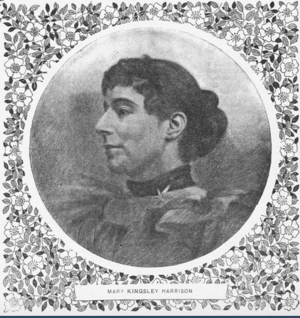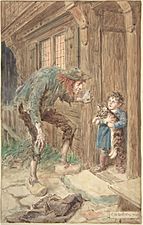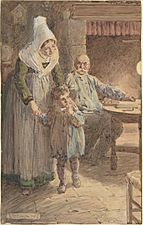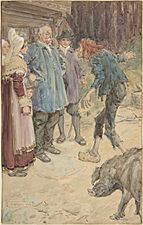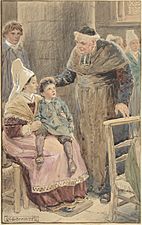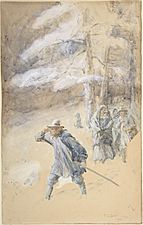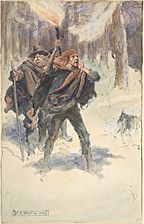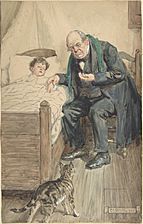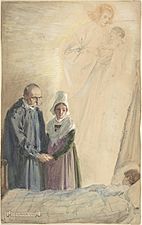Lucas Malet facts for kids
Lucas Malet was the pen name of Mary St Leger Kingsley (born June 4, 1852 – died October 27, 1931). She was a popular novelist during the Victorian era. Two of her most famous books were The Wages of Sin (1891) and The History of Sir Richard Calmady (1901).
At one point, many people thought she was one of the best writers in the English-speaking world. She was even compared to famous authors like Thomas Hardy and Henry James. Her books sold as well as those by Rudyard Kipling. However, her fame faded later in her life, and today, her books are not often read or studied.
Contents
Early Life and Family
Mary St Leger Kingsley was born in Eversley, Hampshire, England. Her father was Reverend Charles Kingsley, who wrote the well-known children's book The Water Babies. Her mother was Frances Eliza Grenfell. Mary was the third of their four children.
She came from a family of writers. Her uncles, Henry Kingsley and George Kingsley, were also authors. Her cousin, Mary Kingsley, was a famous explorer who traveled in Africa. Mary was taught at home and also studied art. She even attended the Slade School, a well-known art school.
Becoming a Writer
In 1876, Mary married Reverend William Harrison. He worked with her father and was a priest for the Queen. After getting married, Mary stopped pursuing her art dreams. Her marriage was not a happy one, and she and her husband soon separated.
After her separation, Mary decided to become a writer. She created her pen name, Lucas Malet, by combining two old family names. Her first novel, Mrs. Lorimer, a Sketch in Black and White, came out in 1882. Her second book, Colonel Enderby's Wife (1885), brought her a lot of attention and praise. This book was a fictional story inspired by her own short and difficult marriage. Years after her husband passed away, Mary became a Catholic.
For much of her life, Malet lived in Europe with her close friend and companion, Gabrielle Vallings. Gabrielle was much younger than Malet and was also her cousin. They traveled a lot together, especially spending time in France. Malet lived in France for many years and was part of important literary groups there. She wrote often during this time, sometimes because she needed the money. Even though she was very successful and popular for a while, Malet faced financial difficulties later in life. She passed away at a friend's home in Wales on October 27, 1931.
Her Books and Writing Style
Even though Lucas Malet is not widely studied today, we know she wrote a lot. She published at least 17 novels, two collections of short stories, and many individual short stories, essays, and poems. She also finished one of her father's novels.
Her writing ideas were influenced by authors like George Eliot and Émile Zola. While her father, niece, and cousin were all writers, Malet is the least studied among them. Her first novel was Mrs. Lorimer (1882), and her first big success was Colonel Enderby's Wife (1885).
The Wages of Sin, published in 1891, is often seen as one of Malet's most important novels. Some critics believe it influenced Thomas Hardy's famous book Jude the Obscure. Not everyone loved her work, though. The author George Gissing once called The Wages of Sin a "wooden book" with no "living character." However, he thought her 1888 novel A Counsel of Perfection was "not bad."
Henry James, another famous author, admired Malet's writing and later became a close friend. Malet's book The Gateless Barrier (1900) is a full-length ghost story. This shows how her writing changed. While her early novels were gentle Victorian romances, by the 1890s, she began exploring more unusual and deeper themes. Her later novels, like The Survivors (1923), started to show ideas found in Modernism, exploring different ways of thinking.
The writer E. F. Benson even mentioned that he learned a lot from her advice in his memoir Our Family Affairs. Malet's last novel, The Private Life of Mr. Justice Syme, was finished by her companion Gabrielle Vallings after Malet's death. It was published in 1932.
Selected Works
Novels
- Mrs Lorimer: A Study in Black and White (1882)
- Colonel Enderby's Wife (1885)
- Little Peter: A Christmas Morality for Children of Any Age (1888)
- A Counsel of Perfection (1888)
- The Wages of Sin (1891)
- The Carissima: A Modern Grotesque (1896)
- The Gateless Barrier (1900)
- The History of Sir Richard Calmady (1901), based on the life of Arthur MacMorrough Kavanagh
- The Far Horizon (1906)
- The Wreck of the Golden Galleon (1910)
- Adrian Savage (1911)
- Damaris (1916)
- Deadham Hard (1919)
- The Tall Villa (1920)
- The Survivors (1923)
- The Dogs of Want: A Modern Comedy of Errors (1924)
She also finished her father's unfinished novel The Tutor's Story.
Short Stories and Novellas
- Little Peter: A Christmas Morality for Children of any Age (1887)
- The Score (1909)
- Da Silva's Widow and Other Stories (1922)
- "A Conversion" (Published in World Fiction 1922. It was later republished as "The Pool" in London Magazine 1930)
- "The Lay Figure" (Published in The Graphic 1923)
About Little Peter
In 1887, a company called Kegan Paul & Co. published Lucas Malet's short book Little Peter: A Christmas Morality for Children of any Age. This book included nine full-page pictures and several smaller ones by Paul Hardy.
The story is about a small boy named Peter who becomes friends with a very unusual and lonely man. This man is not liked by others, but he ends up saving Peter in the end. The book was quite popular and was reprinted many times, even as recently as 2010.
In 1909, another publisher reissued the book. This time, it had eight full-page color illustrations by the famous artist Charles Edmund Brock. By then, it was much cheaper to print books with color pictures, and color was common for children's books. The pictures below show parts of the story.
See also


